Coalescence Modeling for Design of Technical Equipment
Corresponding Author
David Leleu
University of Liège, Department of Chemical Engineering – Products, Environment, and Processes (PEPs), Quartier Agora, Allée du Six Août, 11, 4000 Liège – Sart-Tilman, Belgium
Correspondence: David Leleu ([email protected]), University of Liège, Department of Chemical Engineering – Products, Environment, and Processes (PEPs), Quartier Agora, Allée du Six Août, 11, 4000 Liège – Sart-Tilman, Belgium.Search for more papers by this authorAndreas Pfennig
University of Liège, Department of Chemical Engineering – Products, Environment, and Processes (PEPs), Quartier Agora, Allée du Six Août, 11, 4000 Liège – Sart-Tilman, Belgium
Search for more papers by this authorCorresponding Author
David Leleu
University of Liège, Department of Chemical Engineering – Products, Environment, and Processes (PEPs), Quartier Agora, Allée du Six Août, 11, 4000 Liège – Sart-Tilman, Belgium
Correspondence: David Leleu ([email protected]), University of Liège, Department of Chemical Engineering – Products, Environment, and Processes (PEPs), Quartier Agora, Allée du Six Août, 11, 4000 Liège – Sart-Tilman, Belgium.Search for more papers by this authorAndreas Pfennig
University of Liège, Department of Chemical Engineering – Products, Environment, and Processes (PEPs), Quartier Agora, Allée du Six Août, 11, 4000 Liège – Sart-Tilman, Belgium
Search for more papers by this authorAbstract
A coalescence model in the context of the ReDrop concept (Representative Drops) is proposed to design technical equipment for separating liquid-liquid dispersions in settlers or extraction columns. A fundamental study of drop interactions has been performed to obtain the complete picture of coalescence. The model proposed accounts for collision frequency of the drops, bouncing probability, and coalescence probability, for which the film-drainage approach is applied. The model proposed allows considering the appropriate formulation for different types of equipment. Especially noteworthy is that the coalescence probability fundamentally differs from the expression of Coulaloglou and Tavlarides, which is frequently used, but which shows inconsistencies at fundamental level.
Supporting Information
| Filename | Description |
|---|---|
| ceat201900037-sup-0001-misc_information.pdf166.1 KB | Supplementary Information |
Please note: The publisher is not responsible for the content or functionality of any supporting information supplied by the authors. Any queries (other than missing content) should be directed to the corresponding author for the article.
References
- 1 N. Kopriwa, A. Pfennig, Solvent Extr. Ion Exch. 2016, 34 (7), 622–642. DOI: https://doi.org/10.1080/07366299.2016.1244392
- 2 Y. Liao, D. Lucas, Chem. Eng. Sci. 2010, 65 (10), 2851–286. DOI: https://doi.org/10.1016/j.ces.2010.02.020
- 3 M. J. Prince, H. W. Blanch, AIChE J. 1990, 36 (10), 1485–1499. DOI: https://doi.org/10.1002/aic.690361004
- 4 T. Boublík, J. Chem. Phys. 1970, 53, 471–472. DOI: https://doi.org/10.1063/1.1673824
- 5 G. A. Mansoori, N. H. Carnahan, K. E. Starling, T. W. Jr. Leland, J. Chem. Phys. 1971, 54 (4), 1523–1525. DOI: https://doi.org/10.1063/1.1675048
- 6 H. Sovová, Chem. Eng. Sci. 1981, 36 (9), 1567–1573. DOI: https://doi.org/10.1016/0009-2509(81)85117-2
- 7 W. J. Howarth, Chem. Eng. Sci. 1964, 19 (1), 33–38. DOI: https://doi.org/10.1016/0009-2509(64)85003-X
- 8 F. Lehr, D. Mewes, Chem. Eng. Sci. 2001, 56 (3), 1159–1166. DOI: https://doi.org/10.1016/S0009-2509(00)00335-3
- 9 J. Kamp, M. Kraume, Chem. Eng. Sci. 2016, 156, 162–177. DOI: https://doi.org/10.1016/j.ces.2016.08.028
- 10 C. A. Coulaloglou, L. L. Tavlarides, Chem. Eng. Sci. 1977, 32 (11), 1289–1297. DOI: https://doi.org/10.1016/0009-2509(77)85023-9
- 11 A. K. Chesters, Chem. Eng. Res. Des. 1991, 69 (A4), 259–270.
- 12 M. Henschke, L. H. Schlieper, A. Pfennig, Chem. Eng. J. 2002, 85 (2–3), 369–378. DOI: https://doi.org/10.1016/S1385-8947(01)00251-0
- 13 N. Kopriwa, Quantitative Beschreibung von Koaleszenzvorgängen in Extraktionskolonnen, Ph.D. Thesis, RWTH Aachen University 2013.
- 14 A. Pfennig, A. Schwerin, Ind. Eng. Chem. Res. 1998, 37 (8), 3180–3188. DOI: https://doi.org/10.1021/ie970866m
- 15 G. B. Webber, A. E. Scott, G. W. Stevens, F. Greiser, R. R. Dagastine, D. Y. C. Chan, Soft Matter 2008, 4, 1270–1278. DOI: https://doi.org/10.1039/b717303b
- 16 J. Kamp, M. Kraume, Chem. Eng. Sci. 2015, 126, 132–142. DOI: https://doi.org/10.1016/j.ces.2014.11.045
- 17 D. Y. C. Chan, E. Klaseboer, R. Manica, Soft Matter 2011, 7, 2235–2264. DOI: https://doi.org/10.1039/C0SM00812E
- 18 G. D. M. MacKay, S. G. Mason, Can. J. Chem. Eng. 1963, 41 (5), 203–212. DOI: https://doi.org/10.1002/cjce.5450410504
- 19 S. Hartland, Chem. Eng. Sci. 1969, 24 (3), 611–613. DOI: https://doi.org/10.1016/0009-2509(69)85032-3
- 20 Y. A. Buevich, E. K. Lipkina, Colloid. J. USSR (in English) 1978, 40 (2), 167–171.
- 21 M. Henschke, Dimensionierung liegender Flüssig-flüssig-Abscheider anhand diskontinuierlicher Absetzversuche, Ph.D. Thesis, RWTH Aachen University 1995.
- 22
R. M. MacAvoy, R. C. Kintner, J. Colloid Sci.
1965, 20 (2), 188–190. DOI: https://doi.org/10.1016/0095-8522(65)90009-7
10.1016/0095-8522(65)90009-7 Google Scholar
- 23 J. Ayesteràn, N. Kopriwa, F. Buchbender, M. Kalem, A. Pfennig, Chem. Ing. Tech. 2015, 38, 1894–1900. DOI: https://doi.org/10.1002/ceat.201500097
- 24 Particle Technology and Separation Processes, 5th ed. (Eds.: J. F. Richardson, J. H. Harker, J. R. Backhurst), Coulson and Richardson's Chemical Engineering, Vol. 2, Butterworth Heinemann, Oxford 2002.
- 25 E. Corwin, M. Clusel, A. Siemens, J. Brujic, Nature 2009, 460, 611–615. DOI: https://doi.org/10.1038/nature08158
- 26 N. Kopriwa, F. Buchbender, J. Ayesterán, M. Kalem, A. Pfennig, Solvent Extr. Ion Exch. 2012, 30 (7), 683–723. DOI: https://doi.org/10.1080/07366299.2012.700598
- 27 J. W. Kim, W. K. Lee, J. Chem. Eng. Jpn. 1987, 20 (5), 448–453. DOI: https://doi.org/10.1252/jcej.20.448
- 28 E. Cockbain, T. McRoberts, J. Colloid Sci. 1953, 8 (4), 440–451. DOI: https://doi.org/10.1016/0095-8522(53)90028-2
- 29 T. Gillespie, E. K. Rideal, Trans. Faraday Soc. 1956, 52, 173–183. DOI: https://doi.org/10.1039/tf9565200173
- 30 G. Z. Yu, Z. S. Mao, Chem. Eng. Technol. 2004, 27 (4), 407–413. DOI: https://doi.org/10.1002/ceat.200401884
- 31 M. Henschke, Auslegung pulsierter Siebboden-Extraktionskolonnen, Habilitation, RWTH Aachen University 2003.
- 32 N. F. Carnahan, K. E. Starling, J. Chem. Phys. 1969, 51 (2), 635–636. DOI: https://doi.org/10.1063/1.1672048
- 33 S. Sajjadi, N. Zerfa, B. W. Brooks, Chem. Eng. Sci. 2001, 57, 663–675. DOI: https://doi.org/10.1016/S0009-2509(01)00415-8
- 34 S. Hartland, D. K. Vohra, Chem. Ing. Tech. 1978, 50 (9), 673–682. DOI: https://doi.org/10.1002/cite.330500906
- 35 J. F. Richardson, W. N. Zaki, Trans. Inst. Chem. Eng. 1954, 8, 65–73. DOI: https://doi.org/10.1016/0009-2509(54)85015-9
- 36 F. Buchbender, Single-Drop-Based Modelling of Drop Residence Times in Kuhni Columns, Ph.D. Thesis, RWTH Aachen University 2003.
- 37 H. Speth, Ein neues Modell zur Auslegung von Faserbett-Koaleszenzabscheidern, Ph.D. Thesis, RWTH Aachen University 2004.




